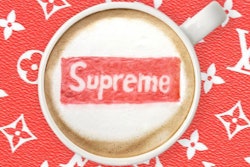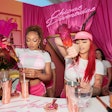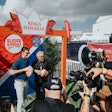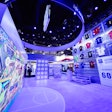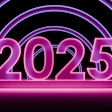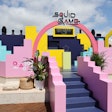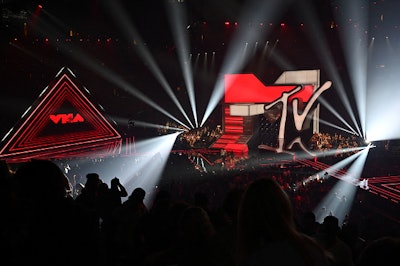
NEWARK, N.J.—MTV’s annual Video Music Awards (VMAs) are known for creating some of pop culture’s most buzzed-about moments—along with plenty of over-the-top staging and performance inspiration for event producers. And this year’s show was no exception.
Held at the Prudential Center on Aug. 28., the ceremony was hosted by LL Cool J, Nicki Minaj, and Jack Harlow. From a big win and new album announcement from Taylor Swift, to a show-stopping medley from Video Vanguard Award honoree Nicki Minaj, to a metaverse-based performance from Snoop Dogg and Eminem, the event offered plenty of moments that drew chatter well into the next day—for better or worse.
We asked event and marketing professionals across the country to share their thoughts on the multi-stage design, the use of augmented reality (AR), the wide range of performances, and much more. Here's what they had to say.
Matt Stoelt
Letter Grade: B+
Returning to the Prudential Center in New Jersey, the 2022 MTV Video Music Awards started off strong with Jack Harlow performing his smash hit “First Class.” Emerging from a cutaway of jet fuselage under the seats, Jack met Fergie on stage, where she stole the show with a surprise performance.
Producers made excellent use of the space, placing the main stage front and center with an old-meets-new set design. Bucking the traditional logo or moon man, the set design included integrated LED screens, an array of moving lights, and over-scaled channel letters that were lit from within. Making for seamless transitions, two triangular-shaped stages were connected to the main stage creating a seamless design for audience integration and quick changeovers.
Taking digital media to a new level, producers used almost every medium possible, including content-rich performances, augmented reality, and digital animation, making the program feel updated and relevant to all generations. On the production side, the support stages featured full LED walls and floors lined with lined moving lights and lasers, making for stunning overall shots of the show. Producers also experimented with on-screen effects that emulated social media filters during Marshmallow and Khalid’s performance of "Numb."
Offering something for everyone this year, Nikki Minaj rocked both stages. The first set featured a giant cutaway Barbie house complete with a winding slide and the other with slick gloss black-clad cages lined with LED and pink powder-coated stripper poles. Performing a seemingly endless montage of songs (and outfits), she took home this year's Video Vanguard Award. Then, throwing it back several decades, the Red Hot Chili Peppers were in the house with a raw and straight-to-the-point performance as they took home this year's Global Icon Award. Appealing to Gen Z and Alpha, Eminem and Snoop Dogg were onstage together before being thrust into the metaverse for their performance.
Always seeming to be plagued by technical glitches, there was a slight delay between the audio and video, but otherwise, things were on point. Overall, the producers did a great job of refreshing this year's show.
Matt Stoelt is the CEO and creative director of Stoelt Productions, an experiential and creative firm with offices in Los Angeles, New York, and Miami, and clients like Louis Vuitton, Instagram, Pandora, Lyft, and Gymshark.
Jordana Kozyreff
Letter Grade: B+
MTV really leaned into digital this year. The graphics and augmented reality were stunning and elevated (most) performances for those watching at home. Coming out of the pandemic, with audiences tired of virtual events, it was a great showcase of what hybrid means and how we should be activating experiences.
That said, the show also solidified the need for IRL and live experience—the worst performances to me were the ones that focused first on digital effects instead of the artists. J Balvin and Ryan Castro’s performance was a miss. And while I appreciated the narrative behind Snoop and Eminem’s metaverse set, I wish I saw more of them! The best part was watching them dub in live from backstage, which most didn’t get to see.
The stage had incredible production value, which is expected from MTV. Nikki’s performance utilized the entire space and from a blocking perspective, was incredibly well-planned, and demonstrated the versatility of the three-stage design. Meanwhile, Lizzo barely moved, but was still completely transported via kick-ass motion graphics that took over the LED set.
As always in show production of this scale—hats off to the massive crew. The perfectly timed and executed resets on each stage were like a choreographed dance.
Jordana Kozyreff is a director on the brand experiences team for global experiential agency Shiraz Creative, where she brings 10 years of experience in production, strategy, art direction, and design. Clients include Colgate, Reddit, Coinbase, Bulgari, Viacom, and Spotify.
Steve DellaPietra
Letter Grade: A-
It’s a welcome surprise when a show’s opener can give you a boost of adrenaline—Jack Harlow’s performance walking down the aisle of a convincing airplane set, the hand-off and nod to Fergie, and the closeout by Lizzo, had the audience energized.
Lizzo’s performance was delivered against creative, well-timed video content and real-time effects, including an interactive mini-keyboard on the stage floor. The intricately timed choreography between Lizzo and the screens might be expected on a tour-based performance and less for a one-off awards show. In the end, the audience answered with a standing "o."
The show’s set consisted of an unabashedly mammoth “MTV” structure on center stage flanked by two triangular LED stages, which matched the performance value of the acts the night had in store. The cohesive design of the screens and the clean, impactful lighting against a sea of audience members’ LED wristbands made for multi-layered eye candy. The sets and construction were meticulously dressed—even the side lighting risers were trimmed out with LED. Although the design of the flanking stages was identical, between the fabulously created video and sets, the producers were able to keep the acts dynamic and original.
Nicki Minaj carried the night with one of the show’s best acts, starting her performance in front of a 2.5-story, “Barb”ie-style dollhouse that fit neatly among the triangle screen backdrop. Kudos to the crew for what must have been a tight changeover to get that in place! The precisely timed rush of fog for BLACKPINK pushed the lighting canvas further into the venue, along with the modern architectural screen content [that] had me scrutinizing (at least a couple of times) to confirm it was indeed the LED screen and not another physical set.
Originality was never lost, even toward the end of the show for Panic! at the Disco’s homage to their song’s music video; [they] began with a classy, widescreen, black-and-white format, and closed bumping into full color among pyrotechnic fountains and bright red balls on the screens behind them.
The use of augmented reality artwork for the award categories was interesting and captivating but otherwise, they were awkward and distracting—particularly during J Balvin and Ryan Castro’s act with the AR twerker and Minaj’s lions. The Eminem and Snoop Dogg performance was greatly anticipated by many fans, but didn’t hold up to the expectations. The metaverse act in particular felt devoid of the artists’ authentic engagement, and felt more of a commercialized introduction to their Bored Ape Yacht Club characters.
The broadcast endured a few minor gaffs and cuts, including one with a wide room video loop that was injected a few times throughout the show—including during a category roll. The longest duration of the clip was used intentionally to cut away during a fashion malfunction with Måneskin.
The remote locations helped to keep the show’s pace. One notable production was Kane Brown’s performance in Fort Lee with the stage’s brilliantly minimalistic light frames. It seemed a great solution to create an exhilarating "big" front against the large cliffs in the background.
Overall, the night was one of the best VMA productions in several years.
Steve DellaPietra is the founder and lead technical producer at DreamVisible, a New York-based production and show management company. Clients have included Pandora, MoMA, IMG, Condé Nast, and amfAR.
Roberto Max Salas
Letter Grade: B-
In general, from a design perspective, it was exciting to see a lot more use of augmented reality (AR) and mixed-reality devices throughout the show. It especially stood out during Ryan Castro and J Balvin's performance, with a giant 3D twerking sculpture, which made a weak performance very visually entertaining, at least. The use of AR was also noticeable in the bumpers before and after commercial breaks and during the category intros. You could see 3D elements floating around the arena in a fun and believable way. Some of these included an awkward yet funny cameo of Johnny Depp as the MTV astronaut.
In other areas, the 3D mixed-reality designs and animations served as a storytelling device, such as during the performance by Kane Brown, in which he landed in a 3D rocket on the stage in a remote area of New Jersey. Last but not least, we had the metaverse performance by Eminem and Snoop Dogg. While this performance had a great intro, it took us into what looked like a pre-recorded music video with a metaverse look, rather than an actual metaverse performance. I think it left a lot of us wanting more innovation.
From a cultural standpoint, the most exciting thing was the diversity that the VMAs showcased this year. Bad Bunny taking "Artist of the Year'' was pretty awesome for me—being Latin myself, it was exciting to see an artist from Latin America take that top award, especially an artist like Bad Bunny. He's breaking stereotypes within the reggaeton genre with female empowerment messages in his music, as well as using his platform to elevate the LGBTQ+ community in Puerto Rico. I also appreciated Anitta being recognized as the first Brazilian artist to win a VMA.
You can see the effort MTV is making in order to bring MTV back to the music; however, it would be great if that didn't happen just for one night. One of my friends even called out that the VMAs ceremony is the one day of the year that MTV is not just running Ridiculousness, because that’s all you can find these days in the rest of its programming.
Roberto Max Salas is the president and co-founder of Young Hero, a youth culture creative agency and production company hybrid that's based in New York. He's worked on events for clients like Absolut, Nike, and TikTok.
Eyal Simko
Letter Grade: A
From the opening act to the farewell goodbyes, the VMAs did not disappoint. Full of high-tech and high-touch elements, the audience was immediately mesmerized by the stage design. The use of LED video tiles on the floor, side rails, and geometric symmetry on each side of the center stage gave the award show a grand experience.
We're seeing neon making a huge comeback in production and design, and you certainly saw lots of that on stage as well. I particularly liked the depth of the stage, allowing for multi-dimensional lighting rigs to create magnetic light shows.
MTV is known for going all out on their productions, and this year certainly did not disappoint. The floating moon man was an excellent homage to the award trophy they hand out, and superimposing Johnny Depp's face on the astronaut goes to show how current and cheeky the VMAs always are. A prime example of this was the use of a metaverse performance by Eminem and Snoop Dogg featuring Bored Ape Yacht Club. Although it was a bit confusing, and we had some mixed feelings about the execution of it, the fact that they are pushing the envelope and incorporating this into a live show speaks volumes about what they truly strive for.
The performances, the stage design, the light shows, and the energy inside that stadium were exactly what we needed to unwind, enjoy, and learn from.
Eyal Simko is the creative director and founder of The One Up Group, an award-winning live experiential agency specializing in full production for clients such as Amazon, Salesforce, Nike, NFL, and more.
Rick Faigin
Letter Grade: C+
As MTV has moved away from the "M" in MTV, they’ve become more desperate to hold onto the influence they once had by now packing as much as they can into one very bloated show each year. They’ve appeared to go to a “kitchen sink” approach, shoving as many genres, generations, and new technology as they can in hopes of relevance. The use of technology in particular, at times, felt overwhelming and distracting, as the star of this show seemed to be the overuse of digital effects, particularly during the artist sets like J Balvin and Ryan Castro (does anyone need to see a giant avatar twerking?). What was billed as a metaverse performance by Eminem and Snoop Dogg ultimately just looked like an animated video gone wrong.
That said, the show was at its best when it allowed artists to do what they do best: Perform. Bright spots included Anita’s electric performance, Jack Harlow’s opening set, the ageless Red Hot Chili Peppers with Flea’s passionate speech, Nikki Minaj’s 10-minute medley of 10 years of hits, and Panic! at the Disco's retro performance. As is often the case, Taylor Swift saved with her surprise announcement of her next album in the waning moments of the show, giving MTV the one thing they’re desperate for: relevance in music.
Rick Faigin is the executive vice president of Acceleration Brand Advisory at Acceleration Community of Companies (ACC), where he oversees client development, strategic partnerships, and cultural marketing strategy for clients such as T-Mobile presents NYE Live with Justin Bieber. He has over a decade of experience in entertainment marketing.
Shaun Gray
Letter Grade: B
One thing MTV has done really well over the last few years with the Video Music Awards is incorporating augmented reality into the program, and that was no different this year! Whether used to highlight screens showing the award that was up for grabs, the nominees, or even elements of the performers' set, AR was front and center at this year's VMAs. I found it overall to be a very enjoyable program that introduced me to music I enjoyed and wouldn't have been able to enjoy otherwise.
The flow of the night's program was really natural, and tied into the theme well. From the very beginning moments of the program where Jack Harlow performed from an airplane cabin, the viewers knew we were about to be transported somewhere. What we didn't know, and something MTV did really well, was that we were about to experience our world getting smaller. LL Cool J, one of the night's three hosts—next to Video Vanguard honoree, Nicki Minaj, and Jack Harlow—told us that this year was going to be the most global and diverse VMAs ever, and he was not wrong! We were transported to New Jersey, Yankee Stadium, and even the metaverse with a performance by Snoop Dogg and Eminem. The two rapping legends' performance in the metaverse was a first for the awards show.
When you can create moments to surprise your guests, that is oftentimes the mark of a great event, and the VMAs did that twice: once at the beginning when Jack Harlow brought out Fergie to sing her hit "Glamorous," which he sampled for his mega-hit "First Class." The other moment we were surprised was when Taylor Swift dropped the bombshell that she has new music coming when she accepted her record-breaking win for Music Video of the Year.
I didn't feel having three hosts that never really engaged or interacted with each other worked last night—it felt disconnected. But I wouldn't let that derail what MTV was trying to accomplish overall, so I would rate the 2022 MTV Video Music Awards with a solid B.
Shaun Gray is the owner of Shaun Gray Events, LLC. Before that, he worked in nonprofit and political management where he produced press events and charity galas for a wide array of causes. Over the last decade, he has been named “Houston’s Best Wedding Planner” by multiple Houston media outlets.
Clint Upchurch
Letter Grade: B-
Settling in to watch this year’s VMAs, I was expecting a lot—expecting to embrace dynamic performances by world-class artists, expecting to be amazed by dynamic stage design, and expecting to see how current technology would be utilized. I think I expected too much.
Jack Harlow wandering through a plane prop, then onto a "red carpet" complete with fake paparazzi (how many of us have produced this very same entrance over and over for corporate events?) ramped up the excitement of this opening number by having Fergie join him. We haven’t seen much of her since her cringe "Star-Spangled Banner" performance, but it was good to see her tonight, and I thought she did a great job.
Lizzo’s high-energy performance was synched perfectly with the video walls, and the energy seemed like this was actually the official opening number for the show. Johnny Depp’s appearance as the floating astronaut kind of fell flat. If I hadn’t heard the rumors that he would be making a cameo, it wouldn’t have been obvious that said astronaut was Depp. It was hard to recognize that it was him, and it was very hard to hear what he was saying.
Speaking of floating things—when will we use holograms so they don’t appear as a gimmick, so they don’t awkwardly float and spin in the air without real purpose? I feel like we have this amazing technology, but we don’t really use it to create awe and inspire engagement. And when it’s used for a performance of two Icons (Snoop and Eminem), instead of watching them perform live, it just falls flat. I felt like I was watching a cartoon—a very well-done cartoon, but a cartoon. Not what I expect when I am watching an international awards show.
Both of the satellite stages—the Doritos Stage that was featured before commercial breaks and the Toyota Stage where Kane Brown performed—felt very pandemic-era to me. Why the need to go to other locations? Why not harness all that energy and talent and keep it under one roof?
Harry Styles missed an opportunity that Bad Bunny definitely took advantage of. Having Bad Bunny’s performance streamed live from Yankee Stadium (where he was in concert), and then receiving his award live at the concert was a memorable and authentic moment. Harry Styles chose to accept his award backstage at his concert, and was so low-key that I wondered how he was going to find the energy to perform an entire concert.
One thing that sets this award show apart from many others is the inclusion of fans—in the pits, on camera, everywhere. However, the constant screaming and audience noise can be a bit much after a couple of hours. I appreciate the energy, but maybe turn down the audience noise a bit for the broadcast audience. I know—I sound like the "get off my grass!" old man here, but the noise was constant and got to be a bit annoying.
And speaking of my old man vibe, why so much ass? Is it really necessary? Is twerking now just the norm? Have we become so desensitized to these images by seeing them on social media daily that we forget that a lot of young kids are watching and are influenced by what they are seeing?
My advice—tighten things up a bit. Make it clear who the hosts are (Nicki Manaj didn’t show up for her hosting duties for over an hour!), keep the speeches shorter, control the audience a bit, and show a little less ass.
Clint Upchurch is the business development strategist for Très LA Group, based in Los Angeles, and has been designing and producing large corporate events for over 30 years. He is an adjunct professor at two California State Universities while speaking and educating at conferences regularly.







